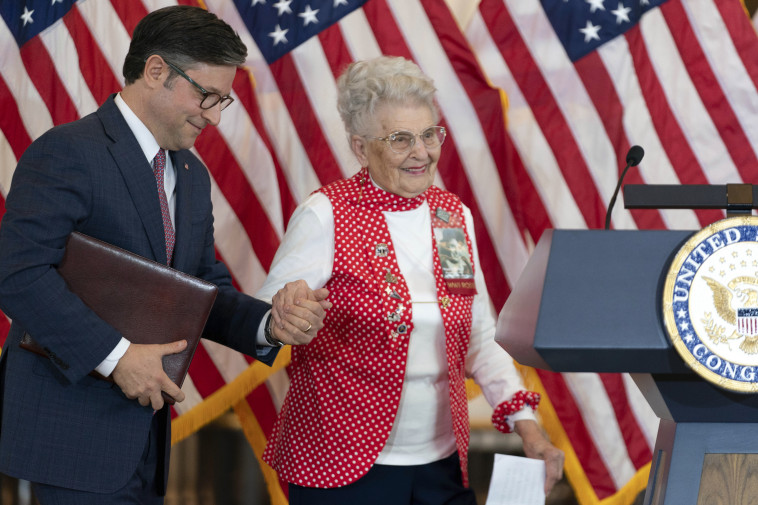If Lila Tomek had her way, she would have fought in World War II alongside her two brothers.
“I figured, ‘If they can go, I’m going too,’” she told The Post. “But they put an end to that.”
Instead, at 19, the Humboldt, Nebraska, native became one of the first 50 women to work at the Glenn L. Martin Bomber Plant — earning 60 cents an hour riveting and splicing cable for B-26 Marauder and B-29 Superfortress planes.
She toiled seven days a week, sometimes as much as 14 hours a day, and was a living embodiment of the iconic Rosie the Riveter image: a woman who rolled up her sleeves and took a factory job to support the war effort while American men were on the frontlines.
Last week, Tomek and other real-life Rosies were recognized in Washington, DC, decades after their service to the nation.
“We didn’t get any special thanks when the war ended,” Tomek, now 101, told The Post. “So it was such a surprise to be acknowledged all those years later. I had to pinch myself to really believe it.”
Twenty-seven women were awarded congressional gold medals — the highest civilian honor from Congress — by Speaker of the House Mike Johnson on April 10, on behalf of the estimated 20 million females who worked to keep the country afloat.
The Rosies, decked out in red and white polka dots, ranged in age from late 80s all the way up to 106.
Tomek called the medal ceremony “a highlight in my life. Most of the women who entered the plants were ready to work, and they were hard-working and patriotic.”
Tomek even remembers Franklin Delano Roosevelt coming to visit the plant where she worked.
“That was quite a thrill to see the president — I had never seen a president before, and there he was saluting us,” she said.
Sylvia Tanis, meanwhile, remembers Henry Ford himself visiting the Detroit Ford factory where she worked from 1942 to 1945, and thanking the women.
“I didn’t ask him for an autograph, because he was my boss,” Tanis, now 99, told The Post.
She was just 17 when she took a job at Ford Motor Company’s River Rouge factory, assembling and repairing the fins of B-25 bomber planes, working 10 hours a day, five to six days a week.
Having grown up in a family on government assistance, the prospect of making $1 an hour at the factory was irresistible to Tanis.
She skipped school to apply for a job, and was hired immediately as a repair person. Because she weighed only 98 pounds, Tanis was easily hoisted via harness to crawl inside the tails of planes for repairs.
“My main purpose was to make sure [soldiers] had their supplies and their airplanes and their guns, so the boys could come home,” she said.
“Back in that day, most people were patriotic. If you were raised in an American home, you became patriotic,” said Susan King.
Now 99, the Baltimore native helped build the wings of fighter jets at Eastern Aircraft Company for 10 months between high school and college.
“My motivation was trying to earn money to go to college,” King told The Post.
Indeed, the silver lining of the homegrown war effort is that it opened up doors for many women — making them more independent, confident and financially stable.
After the war, Tomek married, had two children and established a career in the insurance industry.
“It was a big-time change for women,” she said. “They found out they could do a job, and I would say most of the women who worked in the plant went on to work somewhere else afterwards, because they enjoyed having their own money.”
King, who went on to marry and have two children, used her earnings to fund a master’s degree in education from Morgan State University and worked for decades as a science teacher in Baltimore public schools.
She brought her two daughters with her to the ceremony at the Capitol Building last Wednesday.
“It’s important for the people of America to know that women were important to the war, including black women,” she reflected. “I guess the medals were a way to show to the world what we did.”
“The ceremony was absolutely amazing. It was just absolutely awesome,” Tanis said. “Holy cow, I had thousands of people thank me.”
She and the other Rosies made the most of their time in Washington: “We went to the White House. We went to the Treasury building. We went to museums. We didn’t waste any time, we just kept on going.”
Dolores Leonard, 88, is the “baby” of the group.
As a 7-year-old in Iowa, she searched fields and ditches for milkweed pods, which were used to create life preservers and parachutes for the troops.
“They said two bags save one life,” recalled Leonard, who now lives in Arizona. “It was cold and sticky work. It wasn’t very fun, but it was necessary.”
She made a dime per 15-pound bag of milkweed and donated her earnings back to the war effort by purchasing stamps for her War Savings Bond booklet.
“The experience has always been with me, and [the medal ceremony] just put icing on the cake, so to speak,” the mother of three said. “I raised my girls to be patriotic. I’ve always been proud of the United States and had the American flag flying on our front door.”
For Leonard’s daughter, Lisa Simpson, accompanying her mother to DC last week was a “once in a lifetime” experience — but also a reminder of how the next generation is losing the sort of patriotism that motivated the Rosies.
“I don’t think there are many young adults today who would just set down what they were doing and band together. We don’t see that American spirit, that pride, so much anymore.”
















